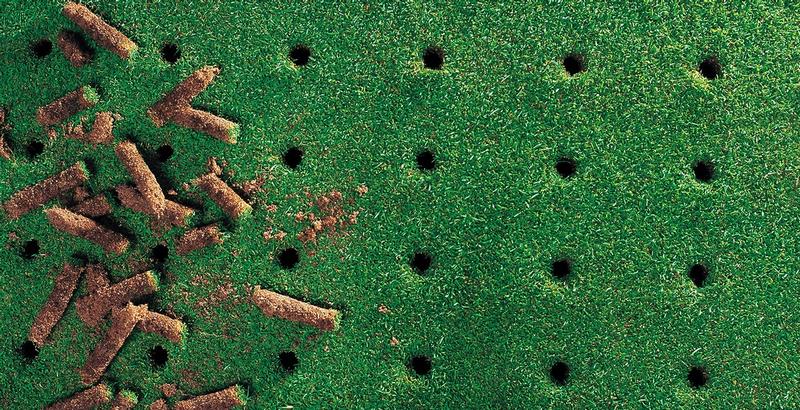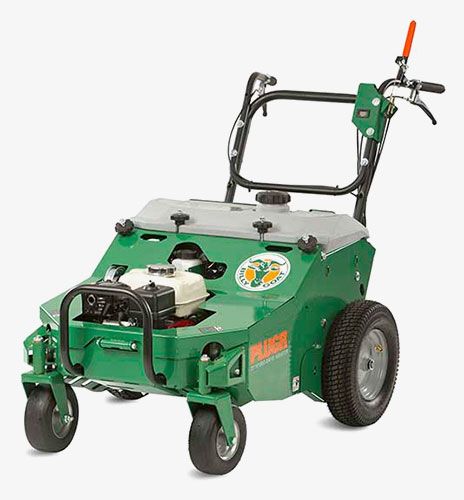
Aerating: Everything you need to know
Just like you and me, grass needs to drink, eat, and breathe to survive. Maybe the two aren't exactly the same, but the point is it's important for your lawn to get the nourishment it needs. Aerating (also called "coring", "spiking", or "aerifying") can help your lawn by allowing air, water, and nutrients to penetrate compact soil and thatch build-up. In this article, we'll go over the reasons for aerating and also explain how and when to do it.
What is aerating?
In simple terms, aeration (sometimes misspelled as "airation") means making holes in the ground to allow air, water, and nutrients to reach the grassroots. It might seem unnecessary, but some soil conditions can make it hard for grass to get the nourishment it needs. Soil that has become too compact will starve the roots of these important elements. The build-up of thatch and debris will contribute to nourishment issues as well. Aerating reduces soil compaction and creates a path through the debris, making way for air, water, and nutrients.
Why should you aerate your lawn?
Unsure about whether aerating is right for your lawn? Consider these scenarios:
- Does your lawn receive a lot of foot or lawn mower traffic?
- Do you have children or pets frequently running around the yard?
- Was your home newly constructed, or has your lawn recently had large, heavy equipment on it?
In all of these cases, your soil will be compact to some degree. Even rainfall can contribute to compaction.

What are the benefits of aeration?
Aeration contributes to the health of your lawn and will reduce the amount of work required to maintain it. Some benefits of aerating include:
- Improved air circulation
- Increased water flow to the soil
- Reduced water puddling and runoff
- Reduced soil compaction
- Stronger roots
- Improved thatch breakdown
- Better heat tolerance
- Fewer pest problems
- Easier to maintain
How to aerate your lawn
There are two methods for aerating your lawn — spike aerating and plug or core aerating. Spike aerating requires simply poking holes in the soil, creating space for air and water. Plug or core aerating involves removing cores from the ground, pulling up chunks of soil entirely and leaving small gaps in the lawn. Spike aerating works better in soil that easily crumbles or is high in loam and sand. Lawns with heavy clay content that are more likely to become compacted would benefit from core aerating.
Aerating with a spike aerator
Using a spike aerator is fairly easy and doesn't require much work up front. Hutson offers John Deere tow-behind spike aerators for riding lawn tractors. Simply hook up the aerator, add cinder blocks as needed to weigh it down, and drive. Hutson also carries STIHL Yard Boss Lawn Aerators. To use one, attach the aerator tines to a STIHL Yard Boss and start walking. The aerator will do the rest. Add a wheel kit to the Yard Boss to make things easier.
With any type of aerator, we recommend making the holes 2-3 inches deep and 2-3 inches apart. Most aerators should come with a fixed setting or will allow you to change these dimensions.

Aerating with a core aerator
Core aerators will require a little more effort but are generally better than spike aerators. One day before aerating, water your lawn so that the soil is moist and easy to aerate. Soil that is too dry will be difficult to puncture or may crumble, preventing the aerator from removing cores. On the other hand, if the soil is too wet, it may get stuck in tines and cause the aerator to compact the soil rather than loosen it.
When the prep work is done, make passes in the same way as you would with a spike aerator, leaving holes 2-3 inches deep and 2-3 inches apart. The plugs should be between 1/2 and 3/4 inches in diameter. After aerating, soil plugs will be covering your lawn. These should break down and disappear after a week or two. You can also break them up with a lawnmower, but you may have to sharpen your blades afterward.
Immediately after aerating you should notice a difference in water puddling and runoff when it rains. Around 7 days after aerating you'll begin to see roots growing in the holes, proving that the grass is receiving additional moisture, oxygen, and nutrients.
Hutson carries a full line of Billy Goat core aerators, including walk-behind and tow-behind equipment. We also carry John Deere tow-behind plug aerators for use with riding lawn tractors or Frontier core aerators for compact utility tractors.
When to aerate your lawn
Lawns need to be mowed and watered frequently but don't require aerating near as often. It's hard to say exactly how often, but most lawn will benefit from aerating annually. If you're maintaining a golf fairway or other sports turf, you should consider aerating 3-5 times a year depending on the amount of use.
The best time to aerate depends on what type of grass you have.
Aerating cool season grass
If you have cool season grass, such as Kentucky bluegrass, both spring and fall will work for aerating. Aerate between March and May or August and November for the best results. Some experts recommend aerating in the fall so overseeding can be done around the same time.
Aerating warm season grass
Warm grasses such as bermudagrass will perform best when aerated from mid-spring to early summer. It's best to wait until after the first spring mowing.
Don't forget to continue mowing, spraying, and watering your lawn as needed. Aerating will promote a healthier, more pest and drought resistant lawn, but won't solve all of your problems.
Not sure which aerator is right for your lawn? Reach out to your local Hutson store and we'll help you find one.
